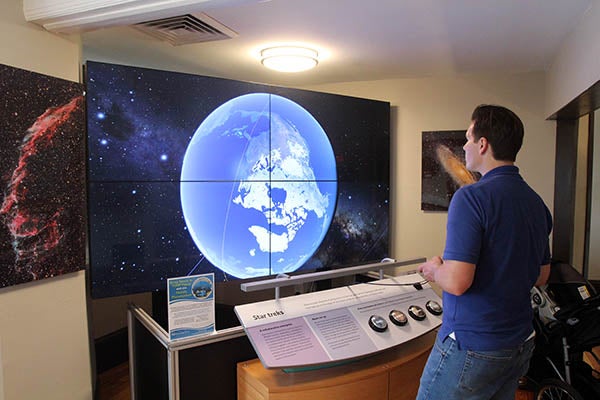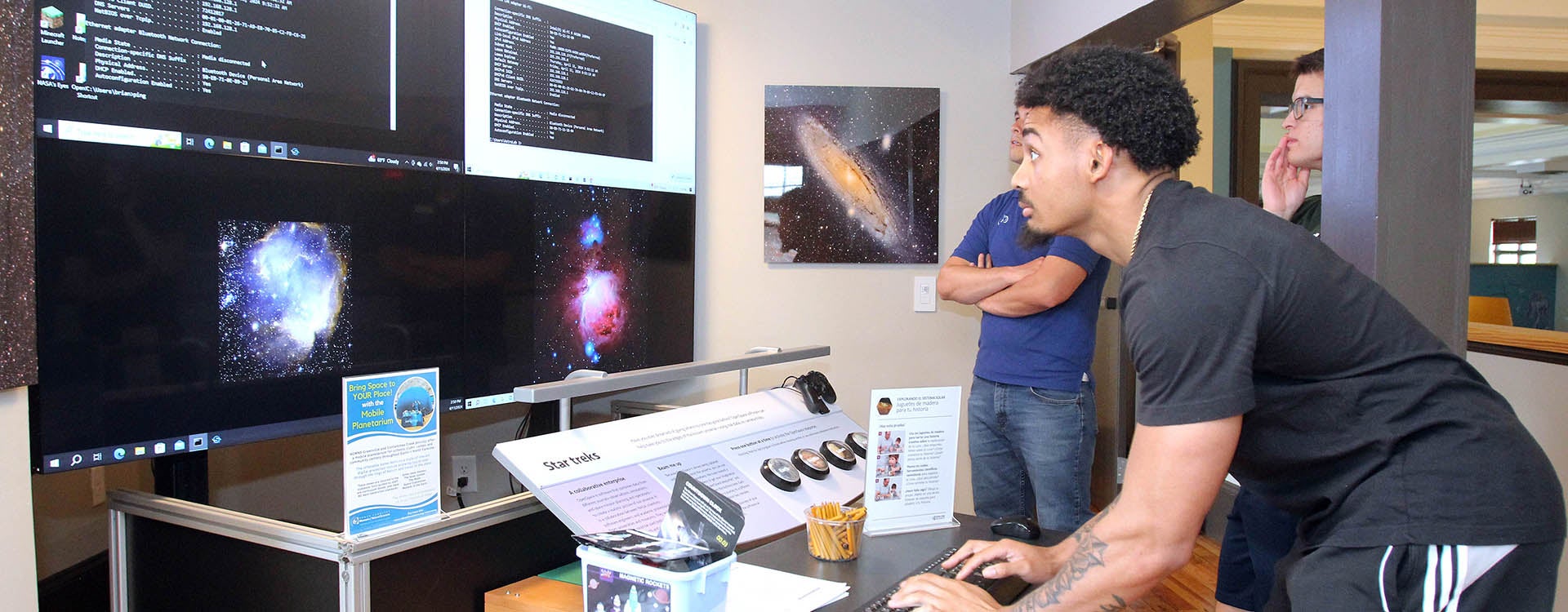Connecting the Universe
Project allows technology students to support museum exhibit
The moon may be nearly 240,000 miles from Earth, but it’s a lot closer in Greenville thanks to the N.C. Museum of Natural Sciences and some East Carolina University technology students.
Six students — Aaron Carey, Henrie Harris, Garret Horn, Freddy Meza-Romero, Carson Roughton and John Wright — tackled a senior capstone project to help improve wireless network connectivity and computer performance of an interactive exhibit about the universe at the museum on 8th Street.
“We’re trying to solve some computer networking lag issues,” said Carey, an information and cybersecurity technology (ICT) major from Greenville. “The exhibit is running two computers at once, and one is lagging behind the other. We’re going to try and see if we can find a solution so that it doesn’t happen.”

Brian Baker, deputy head of science at the N.C. Museum of Natural Sciences in Greenville, works on an interactive exhibit on the universe. Information and cybersecurity technology students have been working with Baker on the exhibit’s wireless network connectivity and computer performance.
The students worked at the museum recently with Brian Baker, deputy head of science at the museum. A child approached, and Baker immediately brought up an image of the moon, zooming in and out and asking him his favorite planet. “Earth is my favorite,” he replies. “Me too,” Baker tells him.
But to get a good, seamless look beyond Earth, two computers need to work in tandem through a program called Open Space. The data visualization software takes real data from space missions, telescopes and observations, and puts it together to produce 3D images of planets, galaxies and other celestial objects on the large screen. One computer is connecting faster than the other.
“This setup relies heavily on Wi-Fi networks and the internet, so it was pretty awesome to get help on a number of things with this exhibit, just getting the most out of it,” Baker said.
He said the Greenville museum also wanted to make the exhibit more user friendly.
“It’s pretty technical and complicated, so the initial task was trying to make it more interactive and easier to use for our walk-in visitors,” Baker said. “We went through a number of different things and landed on the game controller as the best option for that.”
For the ECU students, the project provided a glimpse into the work they’ll do when they graduate. They examined networking, graphic cards, HDMI cables and wireless connectivity.
“They use Meraki-based equipment,” Wright said of the IT company. “I interned with Meraki over the summer, so it was great to have a little bit of knowledge of that. I’m going back to Meraki to work full time when I graduate, so due to this building using Meraki, it just helped me to stimulate my brain a little bit more with using a Meraki device and using the Meraki dashboard, so I would definitely say it helped me moving forward.”
Carey said he appreciated the opportunity to work beyond the classroom.
“Being able to get hands-on work, it’s probably been the most fun,” he said. “You need to actually go to a location and do the work. It’s definitely experience I can use.”
Wright, an ICT major from Knightdale, said he enjoyed collaborating with classmates and working with Baker.
“I really liked having someone — even though we’re college students — trust us to be able to give best recommendations and best practices for IT configurations,” he said.
Wright said the project also provided him a chance to give back to the community, helping the museum and those children who will learn about the universe through the exhibit.
“This is really satisfying because it’s what we went to school for for four years,” he said. “To work, especially in the city of Greenville, we’re able to give back and show appreciation without having to physically say thank you. We can show appreciation in the form of a service.”
And it is service Baker appreciates.
“It’s been really good,” he said. “They’ve been on top of it. We’ve had them out by about four or five times, and they’ve just been bringing some good suggestions and doing some good research into some of the problems that we’re facing. We’ve done a number of different capstone projects, and this is a fine partnership between the museum and ECU. It’s something we hope to continue moving forward.”

Students Aaron Carey, left, and John Wright work on the exhibit at the N.C. Museum of Natural Sciences in Greenville.
